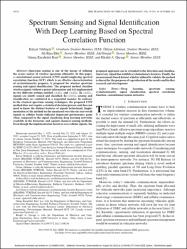| dc.contributor.author | Tekbıyık, Kürşat | |
| dc.contributor.author | Akbunar, Özkan | |
| dc.contributor.author | Ekti, Ali Rıza | |
| dc.contributor.author | Görçin, Ali | |
| dc.contributor.author | Kurt, Güneş Karabulut | |
| dc.contributor.author | Qaraqe, Khalid A. | |
| dc.date.accessioned | 2022-08-16T10:19:24Z | |
| dc.date.available | 2022-08-16T10:19:24Z | |
| dc.date.issued | 2021 | en_US |
| dc.identifier.issn | 0018-9545 - 1939-9359 | |
| dc.identifier.uri | https://doi.org/10.1109/TVT.2021.3109236 | |
| dc.identifier.uri | https://hdl.handle.net/20.500.12462/12453 | |
| dc.description | Ekti, Ali Rıza (Balikesir Author) | en_US |
| dc.description.abstract | Spectrum sensing is one of the means of utilizing the scarce source of wireless spectrum efficiently. In this paper, a convolutional neural network (CNN) model employing spectral correlation function (SCF) which is an effective characterization of cyclostationarity property, is proposed for wireless spectrum sensing and signal identification. The proposed method classifies wireless signals without a priori information and it is implemented in two different settings entitled CASE1 and CASE2. In CASE1, signals are jointly sensed and classified. In CASE2, sensing and classification are conducted in a sequential manner. In contrary to the classical spectrum sensing techniques, the proposed CNN method does not require a statistical decision process and does not need to know the distinct features of signals beforehand. Implementation of the method on the measured over-the-air real-world signals in cellular bands indicates important performance gains when compared to the signal classifying deep learning networks available in the literature and against classical sensing methods. Even though the implementation herein is over cellular signals, the proposed approach can be extended to the detection and classification of any signal that exhibits cyclostationary features. Finally, the measurement-based dataset which is utilized to validate the method is shared for the purposes of reproduction of the results and further research and development. | en_US |
| dc.description.sponsorship | European Commission Horizon 2020 Research and Innovation Programme 876124
Qatar National Research Fund (a Member of The Qatar Foundation) NPRP12S-0225-190152 | en_US |
| dc.language.iso | eng | en_US |
| dc.publisher | IEEE-Inst Electrical Electronics Engineers Inc | en_US |
| dc.relation.isversionof | 10.1109/TVT.2021.3109236 | en_US |
| dc.rights | info:eu-repo/semantics/openAccess | en_US |
| dc.subject | Deep Learning | en_US |
| dc.subject | Spectrum Sensing | en_US |
| dc.subject | Cyclostationarity | en_US |
| dc.subject | Signal Classification | en_US |
| dc.subject | Spectral Correlation Function | en_US |
| dc.subject | Convolutional Neural Networks | en_US |
| dc.title | Spectrum sensing and signal identification with deep learning based on spectral correlation function | en_US |
| dc.type | article | en_US |
| dc.relation.journal | IEEE Transactions on Vehicular Technology | en_US |
| dc.contributor.department | Mühendislik Fakültesi | en_US |
| dc.contributor.authorID | 0000-0003-0368-0374 | en_US |
| dc.identifier.volume | 70 | en_US |
| dc.identifier.issue | 10 | en_US |
| dc.identifier.startpage | 10514 | en_US |
| dc.identifier.endpage | 10527 | en_US |
| dc.relation.publicationcategory | Makale - Uluslararası Hakemli Dergi - Kurum Öğretim Elemanı | en_US |


















